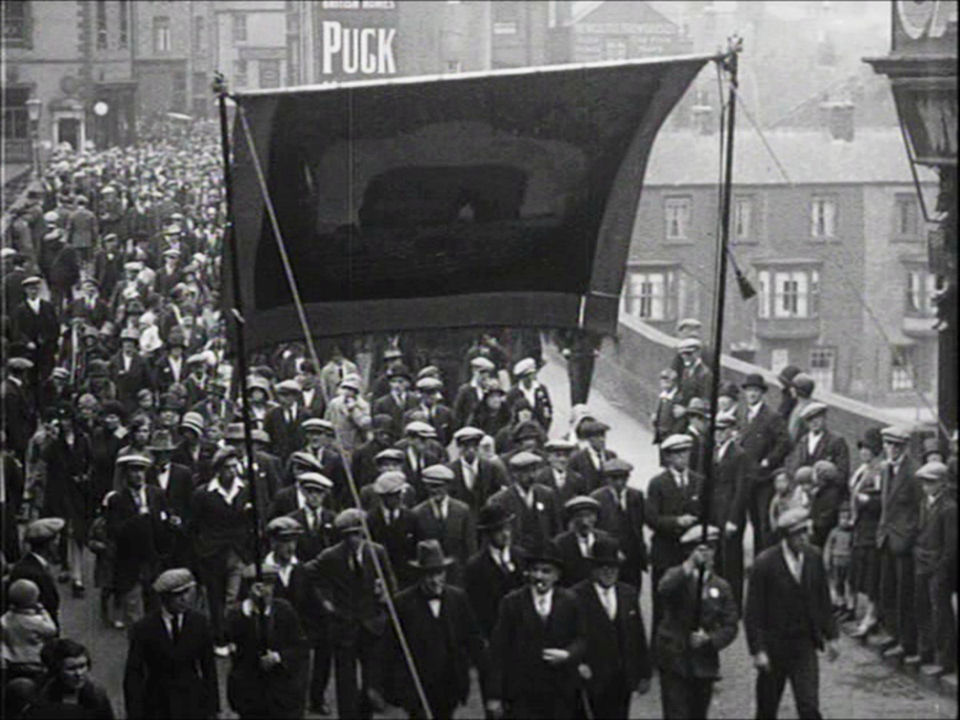PWE and the Durham miners
Document of the month: FO 898/514/49-50
Guy Woodward on the deployment of the Durham miners in wartime propaganda – and the role of a Durham MP in the PWE
This leaflet appears in a file of leaflets and booklets produced for distribution in France. It is dated 28 December 1940 and is addressed from ‘des mineurs du basin de Durham, l’une des plus puissantes fédérations syndicales des mineurs britanniques’ / ‘the miners of the Durham coalfield, one of the most powerful associations of British miners’ to ‘mineurs actuellement sous le joug des Nazis’ / ‘miners currently under the yoke of the Nazis’.

The leaflet is a single sheet and features on the front an image of two miners, stripped to the waist, mining underground using pickaxes, stressing the physical strength and bravery required. The reverse shows a swastika hanging from a gallows at sunrise, with the caption ‘Le jour approche…’, suggesting that the vanquishing (and crucially the punishment) of the Nazis is in sight – an expression of extreme optimism in December 1940, seven months after the Dunkirk evacuation and with the Blitz at its height.

The leaflet indicates the fame of the Durham miners among industrial and trades union communities in Europe at this time. Addressing the French miners as ‘camarades’ / ‘comrades’, the leaflet promotes solidarity between workers in Britain and in occupied France. It decries the ‘crimes’ and ‘barbarous treatment’ meted out by the Nazi occupiers, and also seeks to refute ‘the attempts being made in each of your countries by these people of a depraved species, now known as Quislings, who would have you believe that England will not be able to last long.’ Without specifying the leaflet continues to assure the French readership that ‘the events of the last six months, and what happens every day under our eyes, show how false this is.’
Sending greetings for the coming year ‘from each mining village, from the home of each miner in Durham and Britain’, certainty is expressed that ‘the reign of the Nazi bandits is coming to an end’ and that despite the darkness ‘the ray of light that illuminates our path will also appear to you and give you the strength to shake off the yoke of tyranny, despotism and cruelty.’
The leaflet makes no attempt to encourage sabotage or subversion, but simply seeks to extend a hand of friendship, to foster a sense of solidarity and to encourage fortitude against the occupier – a similar leaflet offers greetings from ‘les ouvriers de Coventry’. In the field of black propaganda, however, attempts were made to foment resistance to the German occupation using trades union rhetoric or channels of communication. And, perhaps not coincidentally, the foremost advocate of this approach in the British government in the early years of the war was Hugh Dalton, the Minister for Economic Warfare and Labour MP for Bishop Auckland.

Dalton had lost his seat in the 1931 election, catastrophic for Labour, but had been determined to return as MP in 1935: ‘My heart was in Bishop Auckland and in County Durham, and especially with the miners.’[1] In his autobiography he writes of his pride at being featured on the banner of the New Shildon Lodge – Dalton also appeared on the banner of the Whitworth Park Lodge seen above.[2] Strongly anti-appeasement in the late 1930s, Dalton was appointed to the cabinet in Churchill’s coalition government and asked to take charge of the new Special Operations Executive, formed to conduct irregular warfare in occupied Europe. On 16 July 1940 Churchill ordered Dalton to ‘set Europe ablaze’, and described his department as the ‘MUW – Ministry of Ungentlemanly Warfare.’[3] In this spirit Dalton referred to this period as ‘my Black life’, and told his cabinet colleagues on 17 August 1940 that ‘we must learn, for the duration of this war at least, to shed many inhibitions and to act on the assumption that the end justifies the means… We must beat the Nazis at their own game.’[4]

Dalton’s plans involved the mobilisation of socialist parties and trades unions in Europe as a means of creating fifth columns and causing ‘explosions, chaos and revolution.’[5] He hoped for strikes, boycotts and sabotage, and advocated the formation of movements comparable to Sinn Féin, to Chinese guerrilla fighters, or to Spanish irregulars in Wellington’s campaign during the Peninsular War of the early nineteenth century.[6] These plans never bore fruition, and the historian David Stafford has observed that Dalton’s vision of Europe in permanent revolution, with the Germans plagued by constant military and civil unrest, rested on over-ambitious assumptions about the willingness of European socialist parties and trades unions to want to pursue such activities and to do so at the behest of the British government.[7]
At home meanwhile, many in government and the military believed that a German invasion of Britain was imminent, and preparations were being made to plan for resistance activities in the event of Nazi occupation. Also held in the PWE archive, minutes of a meeting held on 17 November 1940 to discuss ‘Policy to France’ record Dalton’s comments to senior officials that:
if the Germans were in occupation of Great Britain, and he was trying to organise a movement against them, he would choose people like his own constituents, the Durham Miners, and he would sent to them, not a bank clerk or commercial traveller, but one of their own men, in whom they would have confidence. Similarly, in training Agents for work in France, we should send to the industrial workers men who understood them and whom they trusted.[8]
Dalton’s sense of commonalities between the Durham miners and the French industrial workers is reflected in the leaflet dated just over a month later. Had a German invasion of Britain taken place, Dalton wrote in his autobiography that he would have wanted to travel north to Durham – he recalled Winston Churchill’s plan in the event of a German invasion to deploy the slogan ‘You can always take one with you’ to encourage hand-to-hand combat, and writes that ‘Nowhere would that slogan have echoed louder than in the County of the Faithful Durhams.’[9]
Images by kind permission of The National Archives and Beamish, the Living Museum of the North
Notes
All archival material is Crown Copyright and is held in The National Archives. Quotations which appear here have been transcribed by members of the project team.
[1] Hugh Dalton, The Fateful Years: Memoirs 1931-1945, (London: Frederick Mueller Ltd, 1957), p. 21.
[2] Dalton, p. 137.
[3] Dalton, p. 366.
[4] Stafford 29
[5] Dalton, p. 367.
[6] Dalton, p. 368.
[7] David Stafford, Britain and European Resistance 1940-1945: A Survey of the Special Operations Executive, with Documents, (London and Basingstoke: Macmillan, 1983), p. 30; When the PWE was formed in September 1941, Dalton originally served on the tripartite ministerial committee established to supervise its activities, but was angry that PWE had taken responsibility for covert propaganda from SOE. Due in part to irreconcilable conflicts with his colleagues at the Ministry of Information he was moved to the Board of Trade in February 1942.
[8] ‘Policy to France: Short Record of a Meeting held on Sunday, 17th November 1940’, FO 898/9/49.
[9] Dalton, p. 337. Dalton’s reference to the ‘Durhams’ here is to the Durham Light Infantry, whose service in the Second World War he also hails.
